Lately I’ve been seeing a lot of press about tea machines being launched or being developed. You know the ones: they claim to make you a cup of tea so perfect you’re going to pee rainbows.
The general narrative seems to be that when you have a tea machine it’ll take any tea and know how to brew it correctly, heating the water to the correct temperature and controlling the steep time so you optimise the flavour and texture. Sounds great, except it seriously underestimates several other crucial factors in tea-making: water quality, tea to water ratio and the differences in individual palates.
The other issue is access. Any appliance that requires users to control or guide it via an app immediately assumes you have a compatible phone and that it is available every time you want a cup of tea. Way to go complicating a beverage of hot water and tealeaves.
So here are some tea machines you might have seen around.
Kuchef Tea Maker
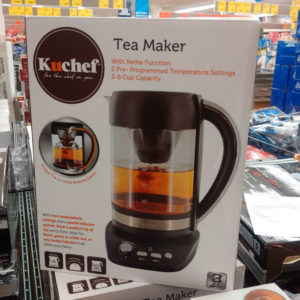 I saw the Kuchef Tea Maker at Aldi as one of their weekly specials just over a year ago and I dare say it makes an occasional appearance on the front tables from time to time. From memory it wasn’t very expensive, maybe $60 or so.
I saw the Kuchef Tea Maker at Aldi as one of their weekly specials just over a year ago and I dare say it makes an occasional appearance on the front tables from time to time. From memory it wasn’t very expensive, maybe $60 or so.
How it works: You put tea in the upper filter basket and water into the glass receptacle. When the water heats to a preset temperature of either 85°C or 100°C, the basket lowers itself to steep. Steep time depends on the number (1,2 or 3) you indicate on the Strength Control dial. The kettle acts as its own teapot.
Biggest pro: Tea automatically kept warm for up to 30 minutes.
Biggest con: You have to clean the whole thing every time you use it.
There’s no doubt this is a great device if you have the same kind of tea all the time (and it brews at 85°C or 100°C) and tend to forget it either when it’s steeping so you overbrew it or let it go cold in your cup, but there’s not much else for the rest of us. You’d still have to do the work of measuring the tea and figuring out temperature and strength and just forget about any delicate greens you want to brew at 60°C.
Because I’m super lazy I think cleaning my Hario teapot (it’s glass and has a very wide infuser basket) is a pain* so the idea that you’d need to clean the whole thing after every use sounds like a nightmare. To me, this is actually more work than using a kettle.
Gourmia Tea-Square
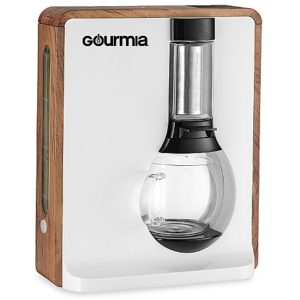 Coming in at about US$150 the Gourmia Tea-Square (or GTC8000 to its mother) needs to be more than a tea warmer to justify the cost. It’s a nice-looking piece of kit, all wood and glass and stainless steel, so the kind of kitchen it belongs in probably looks nothing like mine.
Coming in at about US$150 the Gourmia Tea-Square (or GTC8000 to its mother) needs to be more than a tea warmer to justify the cost. It’s a nice-looking piece of kit, all wood and glass and stainless steel, so the kind of kitchen it belongs in probably looks nothing like mine.
How it works: You pour water in the tank and put tea in the stainless steel strainer, which in turn sits in the upper glass chamber. Press a button corresponding to Light, Medium or Strong and the water will heat and then come through the strainer into the glass carafe accordingly.
Biggest pro: There’s a Refresh function that will rinse the tealeaves before brewing, perfect for oolongs and pu’er.
Biggest con: The carafe and strainer are custom fitted to the machine so if you need a replacement you’ll need to get it from Gourmia.
This tea machine appears to work on a combination pressure/drip system where hot water gets pushed through the brewing chamber at a fast or slow rate at a hot or hotter temperature based on whether you picked Light, Medium or Strong. In other words, the strength buttons seem to correlate to temperature as well as brew time, which might result in some… interesting… cuppas. On the one hand, this is a kind of largescale gongfu cha; on the other it’ll make it difficult to brew a strong green or white, which you might want to infuse at a lower temperature but a longer time.
As with the Kuchef, you still have to figure out how much tea to put in the basket and I can’t imagine how you might clean the water tank, which is pretty narrow. But the key reason I’m saying ‘no’ to this machine is that the presentation video for this features a guy banging on about how much better loose-leaf tea is compared to teabags and then goes and brews himself a pot of… wait for it… rooibos. Seriously, Gourmia?! You couldn’t find a script that involved an oolong, just to show how great the Refresh button is? I’m insulted.
Oh, and it doesn’t act as a tea warmer either.
Teforia Infuser
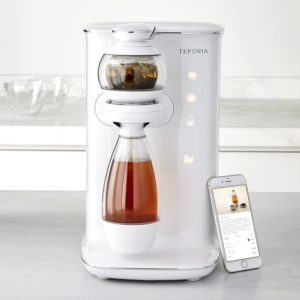 Okay, so the Teforia Infuser reckons you will pee rainbows. It has a water filter and a fancy app that helps you control all the variations, whether you’re using the provided and replenishable Sips tea capsules (with RFID info) or your own tea. At US$1,499, you hope there’s a good cup of tea at the end of all this technology.
Okay, so the Teforia Infuser reckons you will pee rainbows. It has a water filter and a fancy app that helps you control all the variations, whether you’re using the provided and replenishable Sips tea capsules (with RFID info) or your own tea. At US$1,499, you hope there’s a good cup of tea at the end of all this technology.
How it works: You put water in the tank, then scan the Sips tea capsule or input info about the tea so the machine know how to prepare it to enhance certain characteristics. Place tea in the Infusion Globe and make sure the carafe is locked into place. Press Start and the Infuser will prepare the tea accordingly.
Biggest pro: I don’t doubt this results in a superior cup of tea to most other home brew methods for the average consumer.
Biggest con: Too many proprietary parts: water filter, Infuser Globe and carafe are custom-fitted so replacement will be expensive.
I’m going to say this upfront: I hate the idea of tea in capsules for the same reasons I hate the idea coffee in capsules: waste, influence of packaging on beverage flavour and the exploitation of a captive market. Fortunately it looks like Sips won’t have the same issue that Nespresso has with using not-so-fresh coffee in its capsules; the teas all have production years on them and I assume brewing adjustments will be made for the same tea from different years—this knowledge is kind of what you’re paying for when you buy Sips.
While Sips has ‘eco-friendly’ packaging materials, the process to recycle them is rather elaborate. And although you pour Sips’ contents into the Infusion Globe rather than have it punctured by a machine it’s a fuckload more packaging than you would otherwise need for loose-leaf tea which, in my book, equals waste.
If you use your own tea it’s a slightly different story. You need to add the details of the tea to your Tea Pantry on the app, which sounds like a bit of a pain, particularly if you have as many teas as I do. (Did I mention I am lazy?)
The app does have some great features, though. When you input your own tea, you can also adjust how you prefer to have this tea, for example highlight its floral notes. You can also use the app to control subsequent infusions, whether Sips or your own tea.
Also note is there is an obstacle course of technical mastery you need to pass before you can get started. Firstly, the machine needs to be connected to the same wi-fi network as your smartphone to work. You need the app for initial setup but you can use Sips without it afterwards; unfortunately if you need the app every time you want to brew your own tea.
A bit of a downer is you can’t seem to use this as a simple kettle.
Alpha Dominche Steampunk
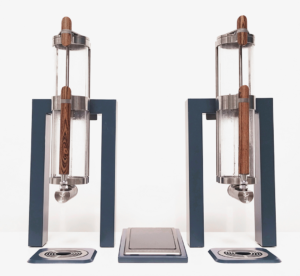 Admittedly the Steampunk is not designed for home brewing and is commonly seen in cafes as a bit of a theatrical drawcard. Yes, it’s a piece of equipment that produces a brewed beverage but it’s so big it can’t help but become an attraction, which you’d want as a positive side effect seeing as the whole shebang will set you back around US$15,000.
Admittedly the Steampunk is not designed for home brewing and is commonly seen in cafes as a bit of a theatrical drawcard. Yes, it’s a piece of equipment that produces a brewed beverage but it’s so big it can’t help but become an attraction, which you’d want as a positive side effect seeing as the whole shebang will set you back around US$15,000.
How it works: Input temperature, time and volume settings. You add water to the lower chamber, which is then heated by steam. You add tealeaves to the top chamber, then a vacuum forces the hot water into the top chamber, agitates it for a bit and then draws the tea liquor into the lower chamber, where you can then dispense it.
Biggest pro: Accuracy of temperature, volume and timing means this machine is ultra consistent.
Biggest con: You still have to know and input all the settings beforehand.
This is definitely a ‘nice to have’ for the hospitality sector. Not only does the Steampunk come with an inbuilt water filtration system, it look speedy and consistent, which makes it perfect for making and selling beverages at the same level as coffee. The biggest downside is still a problem, though; the user still needs to know what they’re doing.
Also I hate to harp on about this, but how the hell do you clean that thing?! It looks like you need to clean both chambers before you can brew another tea, which kinda negates all the pros that might’ve made it great for cafes. I also believe it always needs an app to control the parameters, which is probably asking for tech trouble.
Aviatore Veloce Turbojet 100
The Turbojet 100 is literally a quarter-size jet engine shoved into the bowels of a coffee machine that also happens to brew tea as well. With just 100 for sale at (it’s rumoured) €11,000 it’s really an appliance for super rich people who like to collect this sort of ‘working mechanical art’ but I thought it was a ridiculous enough way to make tea that I wanted to showcase it here.
How it works: Open the dual chambers of the turbine and pour water in one, tealeaves in the other. Select your cup size and place your cup on the cup platform and it’ll use a high pressure system to dispense hot brewed tea.
Biggest pro: Bragging rights.
Biggest con: In no way, shape or form does this look like it might handle tea in more than one way, with the care it needs.
Look, it’s crazy to think anyone I know would own this, or that anything tea-related that came out of it would be any good, but hell I’d love to have a go just for Instagram.
Rise of the machines
There’s no doubt there’s a lot of buzz around these machines because they’re filled with new technology and look pretty schmick, screaming to the world from your kitchen benchtop “I’M SERIOUS ABOUT TEA!” Perhaps for the average tea consumer they produce a superior cuppa, especially those switching from teabags to loose-leaf (which, let’s face it, is not hard). Consistency is probably another plus, particularly for those prone to forgetting about the tea they’ve left steeping too long.
But I can’t say any of these machines can beat a good kettle and a bunch of decent teapots. Consider that most don’t actually operate as water boilers and that’s one extra thing on the bench taking up space in addition to the kettle you need for other things; making jelly, cleaning, mixing honey throat salves, to name a few regular non-tea uses of my kettle.
Having to clean the whole thing every time you want a new tea also sounds like a chore, and that’s coming from someone who regularly hosts tea tastings and has to wash a tea tray, two or three gaiwans and teapots, teacups and utensils every time.
A typical day might see me with a pot of green tea in the morning, then if I’m working offsite I’ll take a tea flask with an oolong in it, which I might refill with hot water a few times. When I’m back home I’ll have another go at the green tea. After that I might decide to have some pu’er using my clay pot and tea tray. A machine has little tolerance for that kind of versatility. I’d have to clean the machine between the green and oolong in the morning; I’d have to decant the oolong leaves into my flask so I could have more when not using the machine, then I’d have to clean the machine again between the oolong and the green and the green and pu’er. Plus I’d lose the tea memory that comes from drinking from clay.
I think the only tea-maker I’d seriously consider here is the Teforia and then only if it came with several Infusion Globes and carafes and a way to use it without the app.
What I hope will happen is that machines will help lift everyone’s tea game. In the same way Nespresso machines moved people from instant coffee to ground coffee at home but gave most people a new appreciation for baristas—actual humans who make coffee at a professional level—I want these machines to move people from teabags to loose-leaf and then present to them the realisation that there are professional tea-makers out there who make awesome cuppas and whose skills are valuable.
Unlike coffee, which needs a special machine to produce barista quality beverage even before you acquire the skills to use it, you don’t need special equipment to make a good cup of tea. It’s seriously as simple as hot water and tea leaves, the rest is convenience and technique.
Truly I can think of a better way to make better tea, and that’s to dedicate yourself to learning and practising tea-making. It’s easy to gain tea connoisseur status by buying a fancy hardware when the real work is updating the software inside your skull.
Other tea machines you might like to check out:
- Blick Kick Tesera Tee Vollautomat (German)
- Breville Tea Kettle
- Cambridge Consultants Tê machine
- Craftea Ultimate Tea Maker
- IQ Innovations Gourmet Fine T machine
- Sharp Tea-Cére Matcha maker
*You know I love you, Hario.
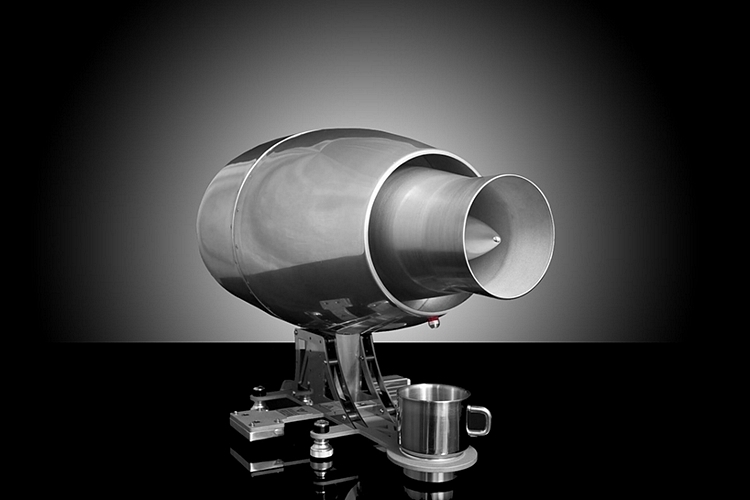
I have heard the steampunk doesn’t do balled oolongs very well. The ultimate test is to get a machine to unroll those little suckers ??